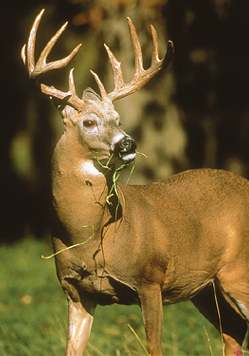|
Whitetail Wheaties
 Camouflage-clothing maker Mossy Oak introduces a revolutionary
high-protein food plot forage-developed by greenthumb deer researchers
in New Zealand-to American hunters Camouflage-clothing maker Mossy Oak introduces a revolutionary
high-protein food plot forage-developed by greenthumb deer researchers
in New Zealand-to American hunters
By Larry Teague
For more than a decade, the makers of Mossy Oak camouflage have
helped legions of hunters hide from game. Now the company wants
to help build healthier stocks of game for hunters to hide from.
Under a just-announced division called "Biologic,"
the West Point, Miss., firm is marketing three food plot seed
blends developed exclusively for quickly putting weight-and antlers-on
deer.
"We see a big need for scientifically proven-and totally
substantiated-wildlife products, whether it be seed, feed or other
products that go with enhancing wildlife," says Mossy Oak
President and founder Toxey Haas, an avid, lifelong deer and turkey
hunter and a frequent visitor to the Lone Star State.
According to Haas, the new food plot blends are like nothing
hunters-or American whitetails-have ever before seen.
When planted and fertilized in the right type of soil, in areas
that receive adequate rainfall, the seeds send up shoots of calcium-
and phosphorous-containing forage that is protein-enriched and
exceptionally palatable to whitetails. Emphasizes Haas, "All
of the other seeds on the market used by hunters to grow food
plots were developed for feeding cattle-not deer."
In many parts of Texas and throughout the South, hunters commonly
plant "food plots" of oats, wheat, ryegrass, clover
and other green vegetation to draw deer where they want them.
In states where "baiting" whitetails is illegal (which
includes scattering corn with battery-powered feeders), growing
food plots isn't.
Food plots furnish thousands of pounds of protein, phosphorus
and calcium that would be too expensive and impractical to supply
to deer herds in any other way.
Though deer are drawn to food plots year-round, they are especially
attracted to them in late winter, when mast and many other types
of natural forage become overbrowsed and scarce.
For bucks to attain trophy sizes, they basically need two things:
plenty of time to age, and the right type of nutrition. That means
allowing immature deer to walk, and supplementing their diets
with protein- and mineral-rich foods in areas where they don't
receive it naturally-in the Texas Hill Country, for example.
No longer is genetics thought to be a significant part of the
trophy whitetail puzzle. Regularly feed a scrawny spike buck the
right types of foods, and in time, he too, can develop into a
quality animal.
Many Texas hunters dole out corn to deer to draw them to their
gun sights during the hunting season. Corn is like candy to whitetails,
but it provides them with very little protein (about 7 percent
by weight) and almost none of the minerals necessary for antler
development.
New to the United States, the Biologic forage was hybridized
in New Zealand for rapidly putting mass on deer raised for the
commercial market. New Zealand exports over 90 percent of the
world's supply of venison-mostly to Europe, where there's a huge
demand for the ultra-lean meat. Europeans consume much more venison
than do Americans.
New Zealand also supplies most of Asia's large-scale demand for
velvet antlers, which, when dried, are used in a litany of medicinal
potions in that part of the world.
continued
page 1 / page 2
| 
